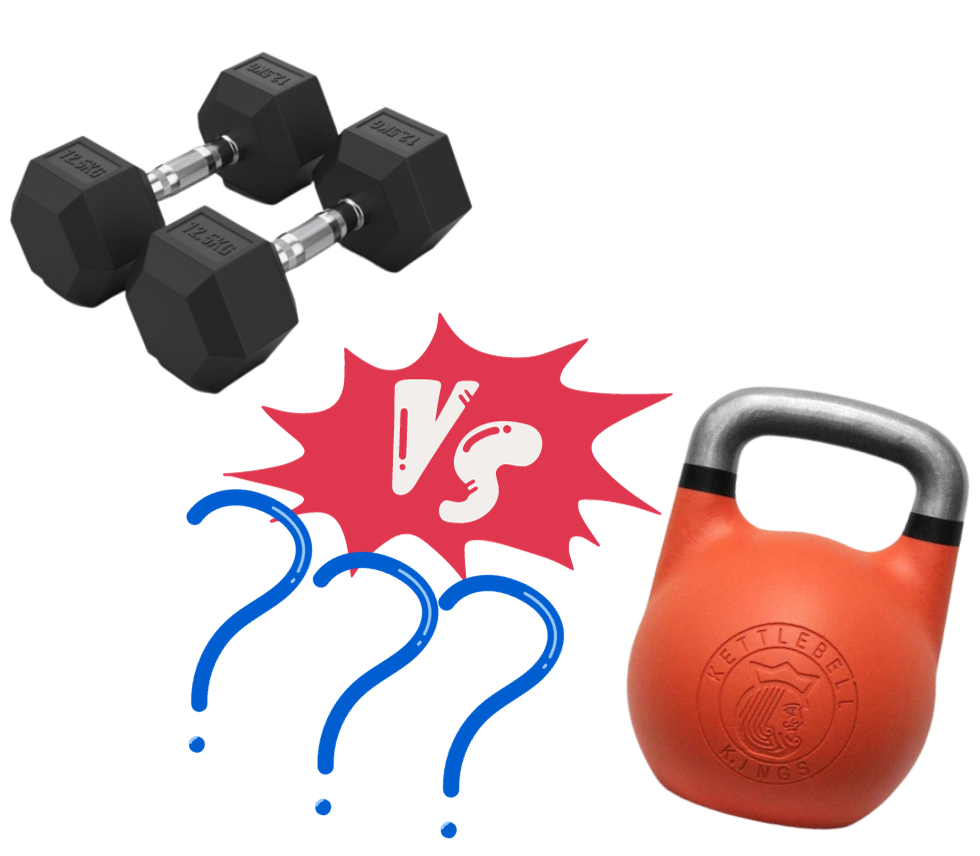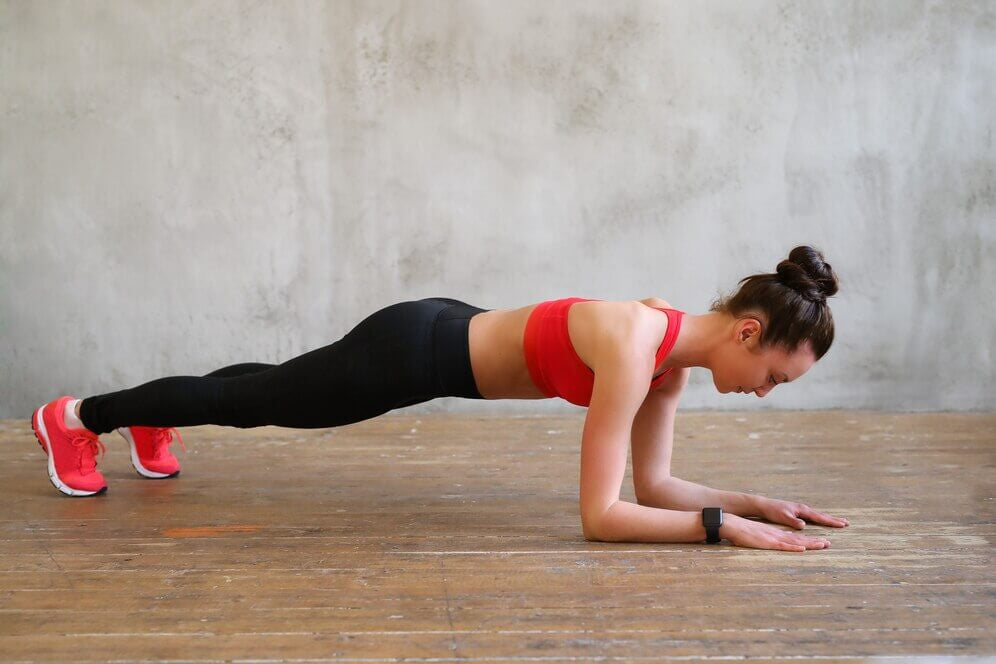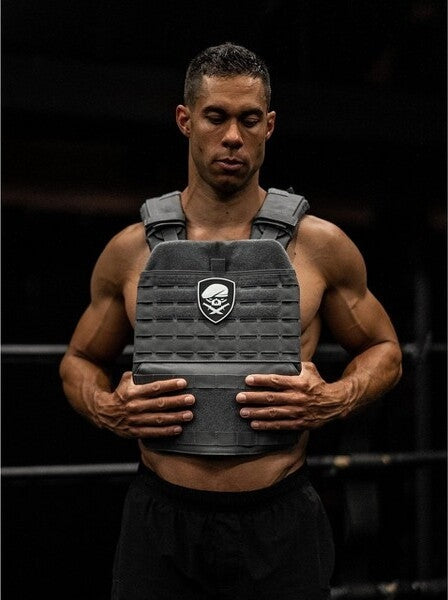When building a home gym, two pieces of equipment stand out: kettlebells and dumbbells. Dumbbells and kettlebells are essential components of any well-equipped gym or home fitness setup, serving multiple purposes. These versatile tools provide the resistance to enhance your strength training, enabling you to develop greater muscle mass and increased power.
If you find yourself torn between the weight rack and deciding which one to use, we are here to answer the question: Which one is better, dumbbells and kettlebells?
Your fitness journey is akin to crafting a masterpiece, with each workout representing a brushstroke on the canvas of your overall health. Just like an artist chooses the finest tools to create a masterpiece, you must know the kind of weight to use for your strength-building exercises.
Differences between kettlebells and dumbbells
Kettlebells and dumbbells are fantastic equipment that can level up your home gym workouts, but they have some distinct differences. Understanding these differences will help you decide which aligns better with your fitness goals and preferences.
- Shape and Design: Dumbbells have a traditional design with a handle in the center and evenly distributed weight on either side. On the other hand, kettlebells have a unique design resembling a cannonball with a handle, providing an off-centered weight distribution. This unique shape sets kettlebells apart and enables various dynamic movements.
- Range of Motion: Due to their design, kettlebells allow for a greater range of motion during exercises than dumbbells. The off-center weight of the kettlebell challenges your stability and engages more stabilizer muscles, making it an excellent choice for functional and full-body workouts.
- Grip and Control: Dumbbells typically offer a more comfortable and secure grip, given their even weight distribution and handle design. This makes them ideal for traditional strength training exercises like bicep curls and shoulder presses. Kettlebells, with their off-centered weight, require a more comprehensive grip and control, enhancing your grip strength and forearm muscles.
Kettlebells for Home Gym Workouts
Kettlebells are unique free weights resembling a cannonball with a handle designed for dynamic and functional workouts. Their center of mass below the handle challenges stability and engages stabilizer muscles, boosting overall strength and coordination. These exercises involve swinging and rotational movements, targeting multiple muscle groups for improved muscle building, athleticism, and coordination. Kettlebell workouts notably enhance hip rotation, core strength, and dynamic flexibility, promoting a solid midsection and lower back for stability and injury prevention.
Benefits of Training with a Kettlebell
With their unique design and functionality, kettlebells offer many benefits that can elevate your training routine. Here are some of the key benefits of training with a kettlebell:
-
It's a good substitute for cardio
Kettlebell workouts are characterized by their extensive repetition range, engaging multiple muscle groups simultaneously. When executed with unwavering consistency, these routines can deliver aerobic advantages akin to those achieved through HIIT training. A study conducted in 2010 revealed that participants engaged in a 20-minute kettlebell snatch workout expended an impressive 13.6 calories per minute—a rate comparable to maintaining a swift 6-minute mile pace while running. Adopting a regimen of kettlebell circuits thrice weekly can elevate your VO2 max by 6 percent in less than a month.
-
It will build your posterior chain strength.
Engaging in exercises such as kettlebell swings elevates your heart rate, facilitates the burning of surplus fat, and strengthens the muscles that constitute your posterior chain—the muscles at the back of your body. The distinctive form and dimensions of kettlebells usher in a unique muscular experience that diverges from the effects of traditional barbells and dumbbells, providing a unique dimension to your workout regimen.
-
It will increase your range of motion.
Kettlebell exercises demand engagement across a spectrum of planes. These planes span from the rhythmic arcs of swings, precise presses, and purposeful carries to encompassing more intricate, dynamic maneuvers.
Further substantiating the advantages, The Journal of Strength and Conditioning Research underscores that kettlebell training not only enriches overall fitness but also confers a distinct boon to the well-being of your lower back.
-
Versatility
From explosive swings to controlled lifts and presses, kettlebells offer a wide range of exercises that can be tailored to your fitness goals. Whether you're aiming to build muscle, increase endurance, or improve flexibility, kettlebells can be adapted to suit your needs.
Kettlebell Exercises to do at Home
Kettlebell swing
- Position yourself with feet comfortably spaced at shoulder width, and place a kettlebell at the midpoint, just in front of your feet on the ground.
- Engage your abdominal muscles while rolling your shoulders back.
- Initiate the motion by pushing your hips rearward and flexing your knees.
- Hold the kettlebell using both arms.
- Inhale, swiftly drawing the kettlebell towards you until your wrists align between your thighs and the kettlebell rests slightly behind your legs, near your buttocks.
- Exhale as you execute a dynamic forward thrust with your hips, propelling the kettlebell upward and ahead of you.
- Conclude the movement with your arms parallel to the floor.
- In a seamless sequence, lower your chest towards the floor while retracting your hips, guiding the kettlebell through your legs and behind you.
- Repeat this cycle for 20 seconds, followed by a 30-second pause. Then, replicate the 20-second set once more. As your strength advances, set a goal of completing 6 to 7 sets, each spanning 20 seconds.
Kettlebell Clean
- Position yourself with a commanding stance, clutching two kettlebells near your thighs. Allow your knees to bend gently, and let your legs embrace a shoulder-width stance.
- Execute a graceful leap in a single, fluid motion, elevating yourself slightly from the ground while extending your arms to achieve an overhead position.
- Execute a gentle and controlled landing, allowing your feet to make contact with the ground softly. As you land, assume a squat-like posture with your knees flexed, and extend your arms directly overhead, maintaining a shoulder-width gap between them.
Kettlebell Snatch
- Hold a kettlebell with one hand, positioning it between your legs. Descend into a squat until your thighs align parallel to the floor.
- Initiate a forceful ascent by propelling through your hips and knees. As the kettlebell ascends to the level of your shoulders, execute a fluid hand rotation and extend your arm to a fully locked-out position.
- Return to a squatting stance and restore the weight to its initial position. Repeat this sequence using one arm, transitioning to the opposite side for a balanced repetition.
Kettlebell Lunges
- Assume a stance with your feet together.
- Hold the kettlebell by its handle using your right hand, allowing your arm to rest alongside your body.
- Ensure your shoulders are retracted, and your chest maintains an erect posture.
- Slowly take a measured step forward with your left leg. Simultaneously, flex your knee while keeping your right foot firmly planted.
- Hold this position briefly for several seconds, then initiate a controlled ascent by exerting force through your forward leg. Lift your body until you are once again standing upright.
- Upon concluding your repetitions on one leg, transition to the other side. Hold the kettlebell in your left hand and advance your right leg.
- Aim to complete a single set ranging from 6 to 8 repetitions for each leg as a starting point. Gradually escalate your routine by targeting 3 to 4 sets as you enhance your fitness prowess.
Recommended Kettlebell Weights
- Beginners can start with an 8-12 kg kettlebell to get accustomed to the movements and avoid straining your muscles.
- People with Intermediate fitness level can progress to a 12-16 kg kettlebell to challenge themselves further and continue building strength.
- For those with significant experience and strength, 16 kg and above kettlebells provide the necessary intensity to take your workouts to the next level.
Looking for versatile kettlebells? Look no further! We offer a wide range of adjustable kettlebells that are perfect for varying your workouts and adjusting weights seamlessly. You can explore our collection here.
Dumbbells for Home Gym Workouts
Dumbbells are simple yet effective tools for a well-rounded home gym setup. These barbell-like weights are versatile, targeting specific muscles for effective muscle development and strength enhancement. They focus on prime movers, aiding in sculpting your physique. Dumbbells excel in targeting various muscle groups, especially glutes, hamstrings, quadriceps, and pectorals, by engaging multiple muscle fibers simultaneously. Unilateral strength training, a key aspect of dumbbell workouts, enhances balance and coordination, reducing muscle imbalances and injury risks. Single-arm exercises boost stability and coordination, challenging core muscles for better functional strength in daily activities.
Benefits of Training with a Dumbbells
Dumbbell training offers many benefits catering to various fitness goals and levels. Whether you're a seasoned athlete or just beginning your fitness journey, incorporating dumbbells into your workouts can significantly enhance your overall fitness experience. Here are some benefits of training with dumbbells:
-
Muscle mass and strength
Dumbbell training engages stabilizer muscles responsible for supporting your joints during movements. This results in improved functional strength, enhancing your ability to perform everyday activities easily and reducing the risk of injuries related to muscle imbalances.
Dumbbell exercises promote balanced muscle development by allowing each side of your body to work independently. This helps prevent asymmetries and muscle imbalances that can occur when relying solely on barbells or machines.
-
Balance and Stability
Many dumbbell exercises, especially those performed unilaterally (one side at a time), require enhanced balance and stability. This helps strengthen stabilizer muscles and improves overall coordination, reducing the risk of injuries caused by muscle imbalances.
In June 2022, a study published in Bioengineering (Basel) delved into a comparison of squat biomechanics involving dumbbells, barbells, and weighted vests. This study revealed that among these options, dumbbells emerged as the optimal choice for novice lifters, primarily due to their supplementary advantages of stability.
-
Versatility
Dumbbells are incredibly versatile tools that can be used for various exercises targeting different muscle groups. From upper body to lower body, core, and even full-body movements, dumbbells allow you to perform diverse exercises, making them an excellent choice for crafting a well-rounded workout routine.
-
They help build bone health.
Engaging in resistance exercise plays a pivotal role in enhancing bone health and staving off osteoporosis—a condition characterized by the weakening and brittleness of bones.
Strength training introduces a beneficial strain on your bones, instigating a response that activates bone-forming cells, thereby conditioning your skeletal structure to handle heightened stress levels. This transformative process contributes to the fortification of bones, as underscored by insights from Harvard Health.
Dumbbells are a remarkable choice in this pursuit due to their multifaceted advantages. Not only are they ideal for beginners, but they also boast versatility tailored to diverse fitness levels. Furthermore, their accessibility and affordability outshine other weight-training equipment. Interestingly, using dumbbells from a standing posture yields superior bone-strengthening outcomes compared to seated machines. This distinction is attributed to the heightened weight-bearing nature of standing exercises, contributing to more substantial bone fortification.
Dumbbell Exercises to do at Home
Dumbbell Curls
- Start by positioning yourself with your feet at a distance equal to the width of your shoulders, gripping a set of dumbbells in each hand.
- Ensure your palms are oriented towards the front, clutching the dumbbells alongside your body using an underhand grip.
- From this stance, lift the dumbbells toward shoulder height, maintaining stationary elbows and a straight wrist. Slight forward movement of the elbows is acceptable if it feels more comfortable.
- Briefly pause at the top of the motion, fully contracting and squeezing your bicep muscles, then gradually lowering the dumbbells back to the starting point.
- Proceed to repeat the sequence for your desired number of repetitions.
Shoulder Presses
- Position yourself with your feet separated at shoulder width, gripping a dumbbell in each hand.
- Lift the dumbbells to shoulder level, ensuring your palms are oriented forward.
- Engage your core muscles and push the dumbbells upward until your arms are fully extended overhead.
- Pause briefly at the top of the movement, then gradually lower the dumbbells to shoulder height.
- Continue performing the sequence for the number of repetitions you wish to achieve.
Dumbbell Lunges
- Maintain an upright posture, positioning your feet at a hip-width distance while gripping a set of dumbbells alongside your body with your palms facing inward.
- Incline toward the ground by flexing your front knee and lowering your rear knee until it approaches the floor.
- Revert to a standing stance by propelling yourself upward using your front leg.
- Continue the motion for your intended count of repetitions, then alternate legs and execute the routine on the opposite side.
Dumbbell Rows
- Place a dumbbell adjacent to a bench or chair on the floor. Stand facing the bench or chair and position your left hand and left knee atop it.
- Grip the dumbbell with your right hand and initiate a pull, ensuring your elbow remains close to your body.
- Pull the weight until it comes into contact with your side, approximately at the level of your belly button. Maintain a flat back that is parallel to the ground throughout the entirety of the motion.
- Contract your lat muscles and squeeze your shoulder blades together at the top of the movement, lowering the dumbbell to the initial position with your arm fully extended.
- Execute a comprehensive range of motion, incorporating a gentle stretch at the lowest point, then iterate the action for your preferred number of repetitions.
- Transition by placing your right knee on the bench or chair, holding the dumbbell with your left hand, and repeating the sequence for the opposing side of your body.
Kettlebells vs. Dumbbells Comparison
|
Aspect |
Kettlebells |
Dumbbells |
|
Shape |
Cannonball with a handle |
A simple bar with weights at either end |
|
Center of Mass |
Below the handle |
Along the handle |
|
Grip Options |
Single grip handle |
Individual handles for each hand |
|
Stability Requirement |
Demands stability due to off-center mass |
More balanced and stable due to even weight distribution |
|
Muscle Focus |
Emphasizes functional movements and engages stabilizers |
Targets prime movers for muscle building and strength |
|
Movement Type |
Swinging, rotational exercises |
Controlled, isolated movements |
|
Advantages |
Enhances functional strength, dynamic flexibility, engages core |
Promotes balanced muscle development, controlled range of motion |
|
Disadvantages |
Requires proper technique to prevent injury |
Limited range of dynamic movements |
|
Pros |
Improves stability, dynamic movements, cardiovascular conditioning |
Offers precise muscle targeting, adaptable to different fitness levels |
|
Cons |
A learning curve, potentially challenging for beginners |
May not fully engage stabilizer muscles, less functional |
Important things to note when selecting the right equipment for your daily workout.
Several important factors come into play when selecting the right equipment for your daily workout at home. Here are some key considerations to keep in mind:
- Fitness Goals: Begin by understanding your fitness goals. Are you looking to build strength, increase muscle mass, improve endurance, or focus on overall fitness? Different equipment caters to various goals, so aligning your choices with your targets will lead to better results.
- Versatility: Opt for equipment that offers various exercises and movements. Versatile equipment allows you to target multiple muscle groups, ensuring a well-rounded workout routine.
- Comfort and Grip: Ensure your chosen equipment provides a comfortable grip and feels natural in your hands. A good grip is essential to prevent injuries and optimize performance during workouts.
- Skill Level: Consider your fitness level and experience with different exercises. Some equipment, like kettlebells, might require a bit more technique and coordination. If you're a beginner, start with equipment you feel confident using safely.
Creating an Effective Home Gym Workout Plan
Crafting an effective home gym workout plan resembles creating a masterpiece, necessitating proper tools, strategy, and creativity. Incorporating kettlebells and dumbbells offer a balanced and diversified training regimen, yielding impressive results.
Balancing Full-Body Workouts and Muscle-Specific Training
Combining kettlebells and dumbbells achieves a balance between full-body workouts and muscle-specific training. Kettlebells engage multiple muscle groups through dynamic movements, like swings and snatches, for comprehensive cardiovascular and strength sessions. Dumbbells allow isolated muscle targeting, ideal for exercises like curls and presses, promoting muscle hypertrophy and definition.
Alternating Routines for Variety and Progress
Alternating between kettlebell and dumbbell routines prevents plateaus and maintains engagement. Varying workouts enhances excitement and challenge, boosting mental motivation. Designate specific days for each – kettlebell days for functional strength, dumbbell days for sculpting. Include active recovery on Sundays with stretching, yoga, or light cardio.
Progressive Intensity and Complexity
Gradually increase workout intensity and complexity to ensure continuous progress. Incorporate advanced kettlebell and dumbbell exercises as confidence and strength grow, fine-tuning the routine for ongoing development.
Home Gym Weight Loss Workouts.
Achieving weight loss goals requires a combination of effective calorie-burning exercises and cardiovascular conditioning. When your home gym has kettlebells and dumbbells, you have a powerful arsenal to create high-intensity workouts that torch calories and elevate your heart rate. Let's explore a variety of sample weight loss workouts that cater to different fitness levels, ensuring you find the perfect routine to kickstart your fat-burning journey.
Kettlebell Swing Circuit
- 30 seconds of kettlebell swings
- 15 seconds rest
- 30 seconds of push-ups
- 15 seconds rest
- 30 seconds of jumping lunges
- 15 seconds rest
- Repeat the circuit for 3-4 rounds
Dumbbell Thruster and Jumping Jack Combo
- 10 dumbbell thrusters
- 20 jumping jacks
- Rest for 30 seconds
- Repeat for 4-5 sets
Kettlebell Snatch and Goblet Squat Circuit
- 40 seconds of kettlebell snatches (alternating arms)
- 20 seconds rest
- 40 seconds of goblet squats
- 20 seconds rest
- Repeat the circuit for 3-4 rounds
Dumbbell Burpee and Mountain Climber HIIT
- 20 seconds of dumbbell burpees
- 10 seconds rest
- 20 seconds of mountain climbers
- 10 seconds rest
- Repeat for 4-5 sets
Other Workouts to Do in Home Gym
While weight loss and overall fitness are essential goals, a well-rounded workout plan should also encompass core strengthening, flexibility, mobility, and upper body strength. Incorporating these elements into your home gym routine enhances your physical abilities and contributes to a balanced and resilient body. Let's explore sample exercises for each category to help you diversify your workouts and achieve a comprehensive fitness level.
Core Strengthening
-
Kettlebell Turkish Get-Ups
This exercise targets your core, shoulders, and hips while improving stability and coordination. It involves a series of movements transitioning from lying down to standing up while holding a kettlebell.
-
Dumbbell Side Bends and Russian Twists
These exercises engage your oblique muscles, enhancing lateral core strength. Dumbbell side bends involve holding a dumbbell in one hand and bending laterally, while Russian twists involve rotating your torso while holding a dumbbell.
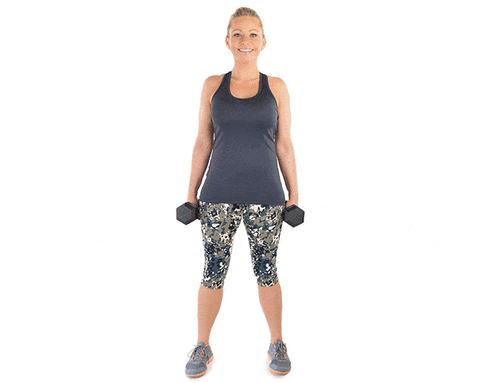
Dumbbell Side Bends
 Russian Twists
Russian Twists
Flexibility and Mobility
-
Kettlebell Halos and Figure-Eight Exercises
Kettlebell halos involve circling the kettlebell around your head, promoting shoulder mobility. Figure-eight exercises challenge your hand-eye coordination and hip mobility as you pass the kettlebell around your legs.
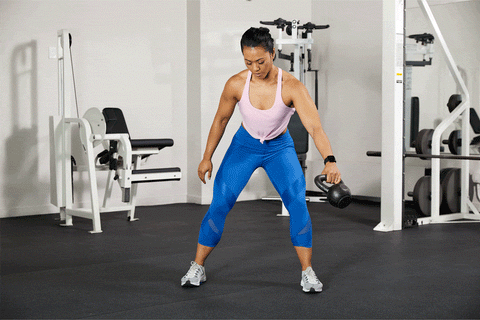
-
Dumbbell Shoulder Dislocations and Triceps Stretches
Dumbbell shoulder Dislocations enhance shoulder flexibility by moving the dumbbell through various ranges of motion. Triceps stretches with a dumbbell help alleviate tension and improve flexibility in the back of your arms.
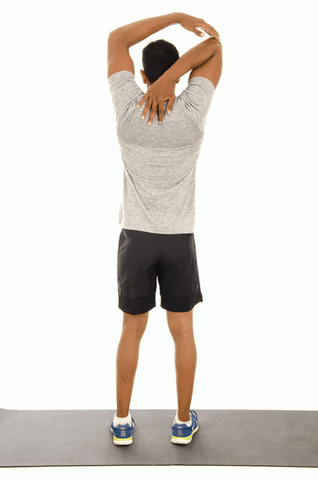 Triceps Stretches
Triceps Stretches
Upper Body Strength
- Kettlebell Renegade Rows
This exercise combines a push-up with a rowing motion, effectively targeting your core, chest, and back muscles. It's a fantastic way to build upper body strength and stability.
-
Dumbbell Chest Press and Lateral Raises
Dumbbell chest presses focus on your pectoral muscles and triceps, contributing to upper body strength. Lateral raises target your shoulder muscles, enhancing shoulder stability and upper body strength.
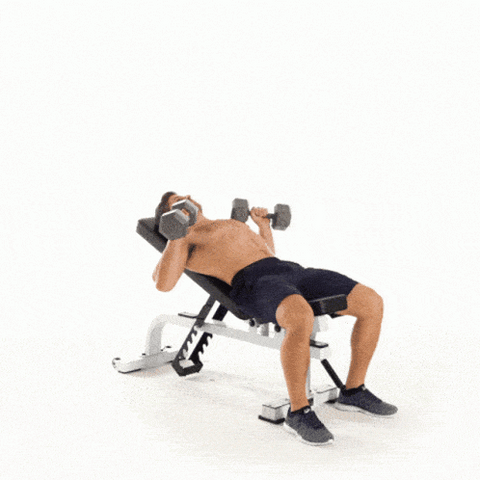
Dumbbell Chest Press

Lateral Raises
Adjusting Workouts for Progression and Challenges
Embarking on a fitness journey involves continual growth and adaptation, necessitating adjustments for progression and safety. Here's how:
Gradually Increasing Weights and Difficulty
Challenge your body by gradually increasing weights and exercise difficulty. Move to slightly heavier weights and advanced variations as strength improves. For instance, progress from basic kettlebell swings to heavier kettlebells or from standard lunges to Bulgarian split squats.
Incorporating Advanced Exercises
Introduce advanced exercises and movement variations for fresh and engaging workouts. Advance from basic dumbbell presses to incline or decline presses. Include complex kettlebell exercises like Turkish get-ups or snatches for added complexity.
Listening to the Body
Avoid overtraining and injuries by listening to your body. Rest and recovery are crucial; pushing too hard can lead to burnout. Pay attention to fatigue, soreness, and decreased performance. Seek professional guidance if persistent pain or discomfort arises.
Maintaining Consistency and Motivation in Daily Workouts
Consistency and motivation are the cornerstones of a successful fitness journey. Building a strong foundation and staying committed to your goals requires a combination of practical strategies and a positive mindset. This section will provide practical tips to help you maintain consistency and motivation in your daily home gym workouts.
- Establish a Routine: Set a fixed schedule for your workouts to make them an integral part of your day. Consistency breeds habit, making it easier to stay motivated.
- Mix it Up: Variety is the spice of life. Experiment with different exercises, workout formats, and equipment to keep your workouts exciting and prevent monotony.
- Visualize Your Success: Imagine yourself achieving your fitness goals. Visualization can be a powerful tool to boost motivation and reinforce your commitment.
- Set Rewards: Treat yourself to rewards for reaching specific milestones. This can serve as both a motivator and a way to acknowledge your hard work.
- Document Your Progress: Keep a workout journal or use a fitness app to track your progress. Seeing how far you've come can be incredibly motivating.
- Prioritize Self-Care: Ensure you get enough sleep, practice stress management, and nourish your body with nutritious foods to support your overall well-being.
- Stay Positive: Replace negative self-talk with positive affirmations. Remind yourself of the benefits you're experiencing and the progress you're making.
- Be Patient: Results take time. Embrace the journey and stay patient, knowing consistent effort will yield positive changes.
Kettlebells and dumbbells are versatile tools with unique advantages for achieving fitness goals. Kettlebells focus on functional strength and athleticism through dynamic movements, improving stabilizer muscles, core strength, hip rotation, and flexibility. Dumbbells excel at isolating and targeting specific muscle groups.
Commitment, discipline, and passion drive your home gym workouts with these tools, bringing you closer to your goals. Combining kettlebells and dumbbells embodies a well-rounded fitness approach that transforms your physique and enhances balance, vitality, and potential in all aspects of life.








